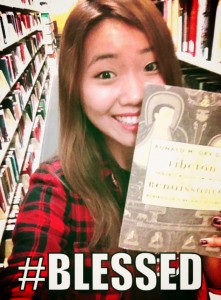I started my journey of finding the right book for my shelfie by searching up “Tibetan Buddhism” in the Lafayette library catalogue. I searched for “Tibetan Buddhism” because whenever I hear the word “Tibet” or “Tibetan”, I associated it with Buddhism. As a Tibetan, the Tibetan holidays I remember celebrating as a child were special and auspicious days for Buddhism so I wanted to see how much Buddhism has impacted the Tibetan culture. After contemplating between several books regarding Tibetan Buddhism, I decided to choose Tibetan Renaissance: Tantric Buddhism in the rebirth of Tibetan culture by Ronald M. Davidson. The cover for the book has really cool drawings of important deities (I believe) although the color scheme is pretty bland. What drew me to Tibetan Renaissance was the brief summary on the back of the book which stated, “Davidson explores how the translation and spread of esoteric Buddhist texts dramatically shaped Tibetan society” because that is exactly what I wanted to find out.
There are ten sections in the book, Tibetan Renaissance which sort of acts like a timeline for Tibet’s adaptation to Buddhism. I personally found the second chapter, “The Demise of Dynasty and a Poorly Lit Path” to be the most interesting because I was able to imagine how Tibet was before the introduction of Buddhism. Learning that Tibet was once a strong militaristic empire is surprising because now people usually associate Tibet with Buddhism which is considered peaceful and compassionate. Learning how Tibet was prior to Buddhism helps me understand how Buddhism has made an impact on the Tibetan culture because it shows how this particular religion turned a country that was once perceived as “the most fearsome armed states in Asia”, into a country everyone now associates Buddhism with. The other chapters later on in the book showcase how the once powerful Tibetan empire crumbles into pieces followed by many political and social unrest. Tibetan Renaissance contains many illustrations of maps and deities which is helpful because it provides a visual understanding of Tibet’s transformation after the introduction of Buddhism. The book also contains a glossary in the back which provides one sentence explanations for difficult Tibetan terms. I plan on using this book for my research paper because it provides background history on Tibet both before and after Buddhism so it will be easier to see how Buddhism impacted Tibet’s culture and its society.
